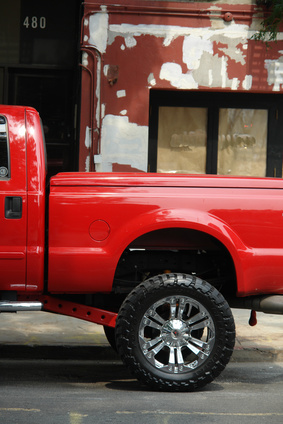
Mag wheels built with a magnesium alloy are a lightweight wheel alternative that doesn’t give up strength due to its lessened weight. Despite their physical advantages, mag wheels are often purchased for their appearance. As such, restoring mag wheels to good condition after they’ve been marred or worn from use is a common car maintenance project. There are two primary methods of restoration, often used together to best effect: polishing and painting. The restoration process can be time consuming, especially when completed by hand. The results, however, are wheels that look as good as new, transforming formerly scratched and worn wheels into an attractive, eye-catching addition to your car or truck.
Place a drop cloth over the floor of your work area to protect from spills.
Clean the mag wheel using car wash soap and water to remove any dirt or debris from the wheel surface. Rinse with clean water and pat the wheel dry with a clean cloth.
Brush the wheel with a layer of paint stripper to remove existing finish from the wheel’s surface. Wait about 20 minutes for the stripper to dissolve the coat finish and then remove the paint stripper by scrubbing the wheel with a stainless steel wire brush to get into any small, hard-to-reach areas around the spokes. Rinse the wheel off with a power washer to remove all the stripper and paint residue.
Sand the wheel with 120-grit sandpaper to even out the wheel’s surface. Run the sandpaper across the face of the wheel in a single direction and around the rim in a single direction until you’ve removed all gouges from the surface. Switch to 220-grit sandpaper and sand the wheel a second time, working perpendicular to the direction used on the face of the wheel and in the opposite direction around the rim to wipe away any sanding lines left from the 120 paper and to smooth the surface further. Continue smoothing the surface switching from 220 grit to 320, 400 and finally 600, always running in the opposite direction of the last pass to avoid building up sanded grooves.
Polish any of the wheel you wish to a shine after smoothing using wet/dry sandpaper. Saturate 600-grit wet/dry sandpaper and buff the polishing areas to a dim shine. Continue buffing by switching the paper with each pass, working upward through 900-grit, 1,000, 1,500 and gaining a high shine on the polished areas with 2,000-grit sandpaper. As with the smoothing process, always work in a different direction with each pass of the sandpaper. Wipe down the wheel with a tack cloth to remove any sanding residue.
Place masking tape over the polished portions of the wheel to paint the unpolished portions without overspray marring the shine.
Spray the unmasked areas with three thin layers of sandable primer to build up a usable coating. Wait five minutes between each layer to allow for drying time, with an additional 20 minutes after the final layer. Sand the primer smooth with 600-grit sandpaper and wipe away the residue with a tack cloth.
Fill an HVLP paint sprayer with the wheel color of your choice. Hook the air hose to a compressor and turn the compressor on. Aim the sprayer at the wheel from a distance of about 8 inches and slightly off to the side and trigger the paint flow. Apply the paint in a back-and-forth motion across the wheel, overspraying it on all sides to ensure complete coverage. Use three thin layers of paint to build up your coat, allowing each layer to dry 10 minutes before applying the next. Wait 30 minutes after the last layer before applying clear coat paint.
Spray a coat of clear coat paint over the painted portion of the wheel as a layer for protection. Build up the coat with three layers of the clear, waiting 10 minutes between each coat for the clear to dry before the next application. Allow the final coat a full night’s drying time before removing the masking tape.